7 Who Learns What and Why: The Economics of Education
Caroline Krafft
Global importance of education
One of the great successes of recent human history has been the expansion of education. Throughout the globe, we have seen enormous progress in terms of human knowledge and skills. These increases in human capital, which in turn increase productivity, have played a critical role in poverty reduction and human progress. However, education does not just affect how productive workers are and their own earnings. Education contributes to economic growth and poverty reduction.[1] Education has an important role in reducing inequality, particularly across generations.[2] Education can help reduce crime,[3] increase political participation,[4] improve health and child health,[5] as well as reduce child marriage, childbearing, and mortality.[6] Education is also instrumental to individuals’ (and especially women’s) empowerment.[7]
Education’s vast potential impact has an important role in how education markets function. Globally, the public sector has a central role in providing education. In this chapter, we will explore why leaving education to the private sector alone will not be economically efficient. We will also examine how the public sector performs in comparison to the private sector in providing education, including issues of quality, efficiency and equity in schooling. The chapter frames debates about education within current global development goals.
Global progress in expanding education
Historically, very few individuals could read or write. Literacy is the ability to read or write. Illiteracy is when someone cannot read or write. Individuals living in the 1800s were more likely to be illiterate than literate (Figure 7.1[8]). In 1870, just 19% of the world’s population was literate. Illiteracy was due, in large part, to limited access to schooling. In 1870, just 10% of people had attained least some formal basic education (had completed at least primary [elementary] education). As Figure 1 shows, there has been an enormous shift in schooling and literacy. By 2020, 89% of the world’s population had at least some education and 87% of the world’s population could read and write. Some countries made enormous improvements in the span of a single generation. For example, Algeria’s elderly (ages 65 ) have a literacy rate of 28% compared to 97% among youth (ages 15-24).[9]
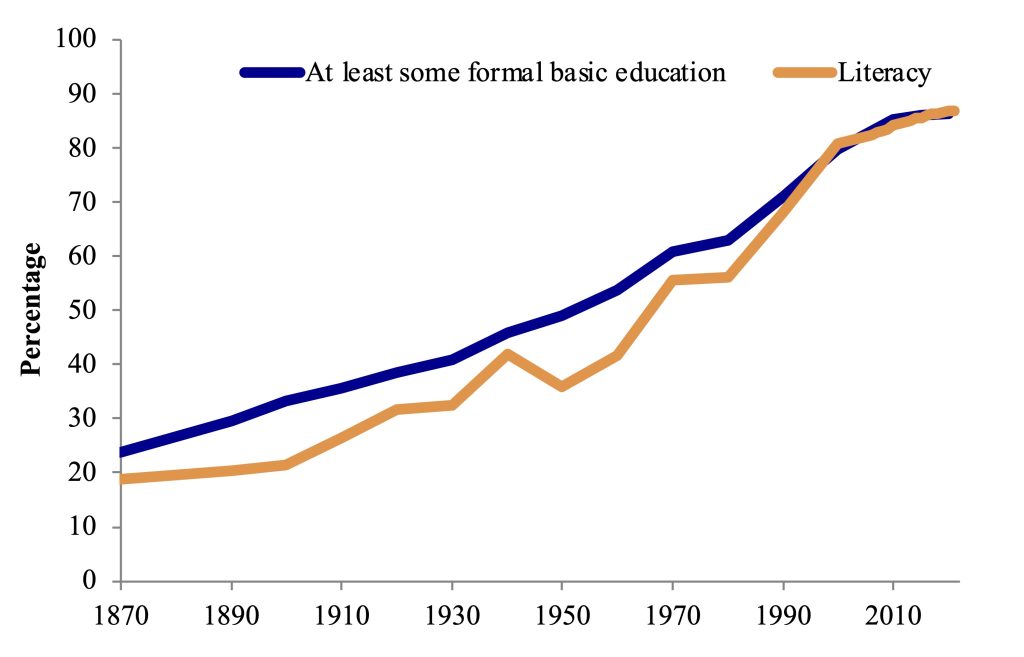
Improvements in literacy and attending school have been uneven across regions. Figure 7.2 shows gross enrollment ratio by region. Gross enrollment ratios (GERs) compare the number of students enrolled at a school in a level (such as elementary, also known as primary schooling) to the number of students who should be in that level. Because the number of students that should be in a level assumes on time progression and no grade repetition, the GER can be greater than 100% if students are delayed in their schooling. Figure 7.2[10] shows GERs for pre-primary (kindergarten), primary (elementary education), secondary (middle (lower secondary) and high school (upper secondary)), as well as tertiary (higher) education for four regions of the world that encompass primarily developing countries. No region has universal pre-primary, although Latin America & the Caribbean and East Asia & the Pacific come close. Sub-Saharan Africa and the Middle East and North Africa lag far behind, with GERs for pre-primary of 28-34% in 2020.
At the primary level, regions have converged towards GERs at or above 100%, although Sub-Saharan Africa still falls a bit short of 100% as of 2020. Secondary education GERs have expanded substantially in every region except Sub-Saharan Africa, where there has been less of an increase with a secondary GER of only 44% as of 2020. Although Sub-Saharan Africa has the lowest enrollments in secondary, other regions still do not have universal secondary access. Recently, particularly since the 1990s, tertiary education access has expanded rapidly in the developing world, with between 41-54% GERs in Latin America & the Caribbean, East Asia & the Pacific, and the Middle East and North Africa in 2020. Sub-Saharan Africa’s tertiary GER is only 10% at the same time.
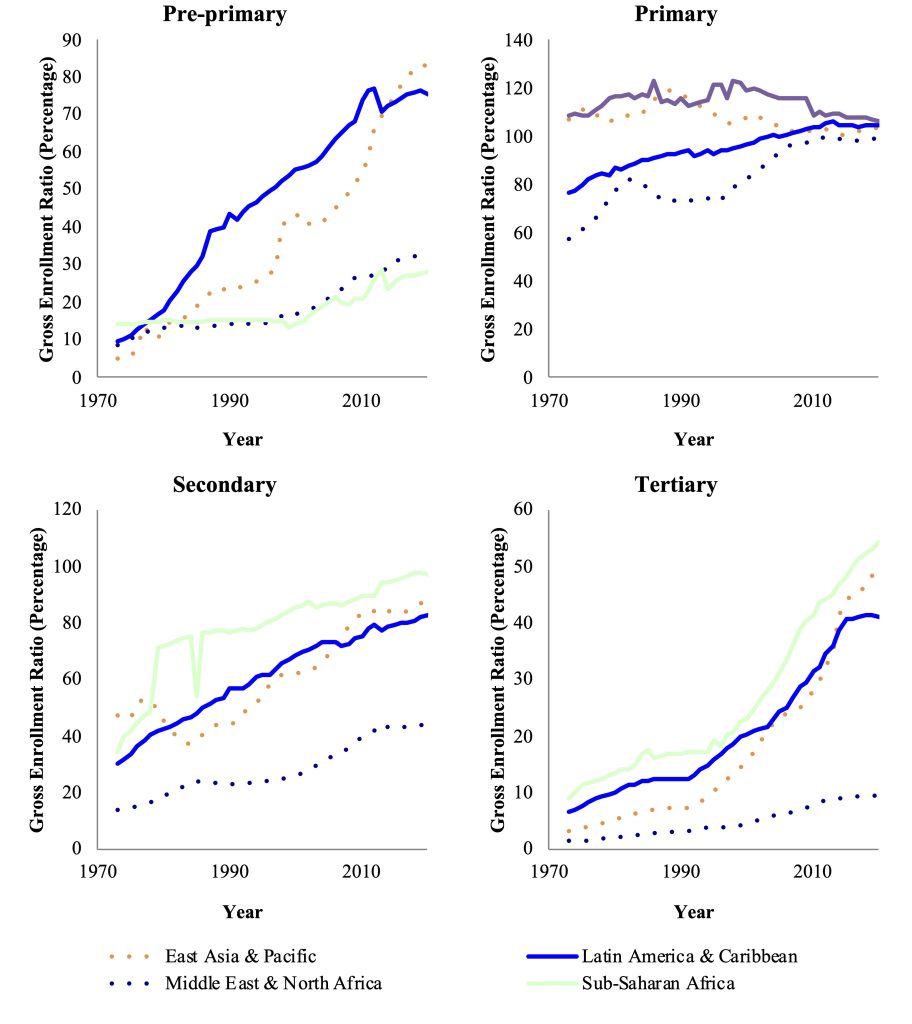
Reductions in inequality
Expanding access to education has also reduced some forms of inequality. Figure 7.3[11] shows the ratio of years of schooling for women to men, as a percentage, for adults ages 15-64. Although in the 1800s, no country had gender equity, by 2010 Latin America and the Caribbean, Eastern Europe, and the Advanced Economies had all achieved gender equity in years of schooling. Other regions had made major progress as well, with women having, on average, between 82% and 87% the amount of schooling of men.
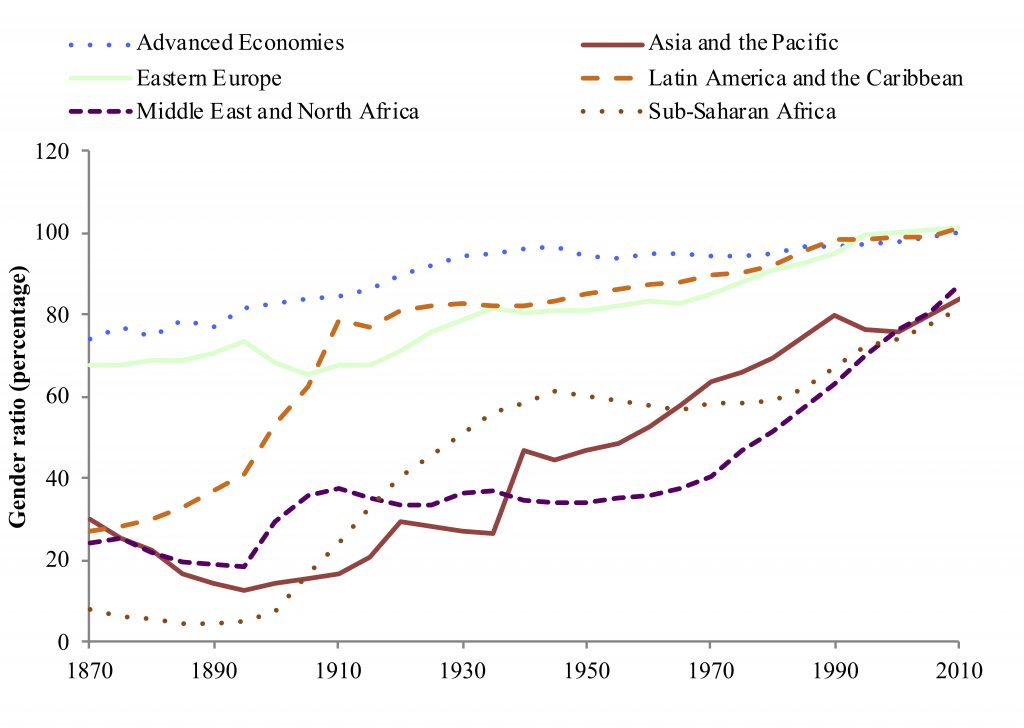
Problems with education quality
There has been an enormous expansion in access to education throughout the world, with the potential to dramatically increase human capital and improve a wide variety of economic and social outcomes. The payoffs to education depend, crucially, on how much students learn in school. In this regard, there has been less progress than enrollment trends suggest. Figure 7.4[12] shows the percentage of students in grade two who are unable to read even one word in a short text. The share unable to read is as high as 90% in Malawi, 85% in India, and 83% in Ghana. Only in one country—Jordan—of the countries examined is the share unable to read below 25% (11% are unable to read in Jordan). The failure to learn to read—even one word—after two years of school is a symptom of a global “learning crisis.”[13] Enrollment—being in school—is not the same as learning. Learning, acquiring human capital, is what contributes to economic and social outcomes, so the learning crisis means that globally education is falling short of its potential.
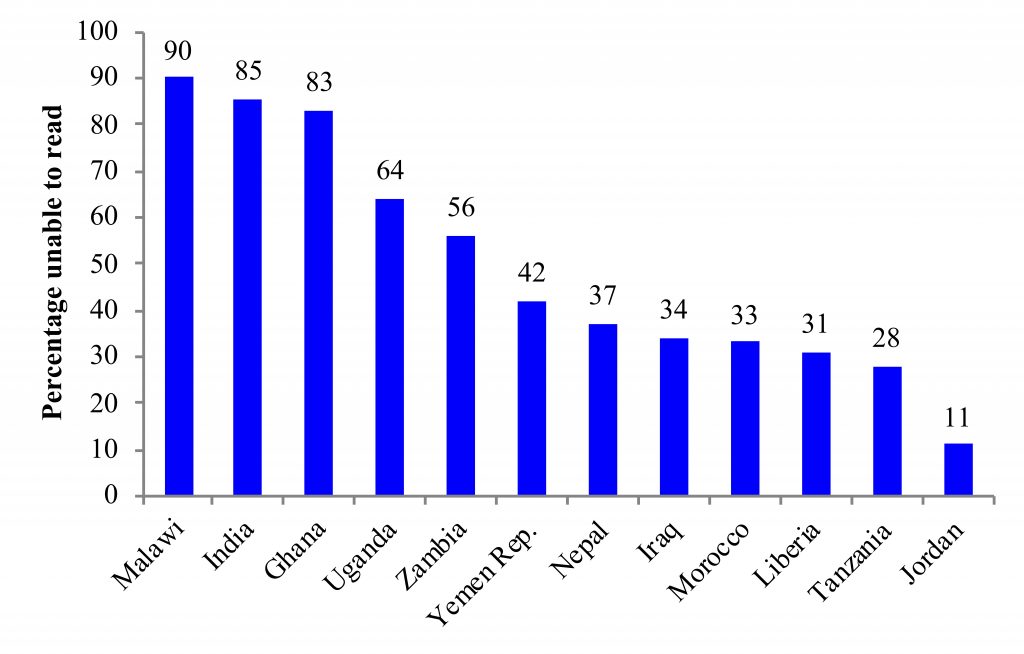
The shortfall in education’s potential is an issue not only in developing countries but developed ones as well. Figure 7.5[14] shows countries’ average scores on the Trends in International Mathematics and Science Study (TIMSS). The TIMSS is an international standardized test. Scores range from 0 to 1,000. The tests also have benchmark scores for different levels of achievement, from low (400) to advanced (625). There are a number of countries, such as Morocco and South Africa, whose average scores do not even meet the low benchmark. The United States, with an average score of 515, is two points below Hungary, and passes the intermediate but not the high benchmark. Only a few countries, including Japan (594), Hong Kong (578), Taipei (612), South Korea (607), and Singapore (616) surpass the high benchmark. The TIMSS results show that there is substantial room for improvement in the quality of education in both developed and developing countries. How to improve quality is a thorny question we will examine in subsequent sections.
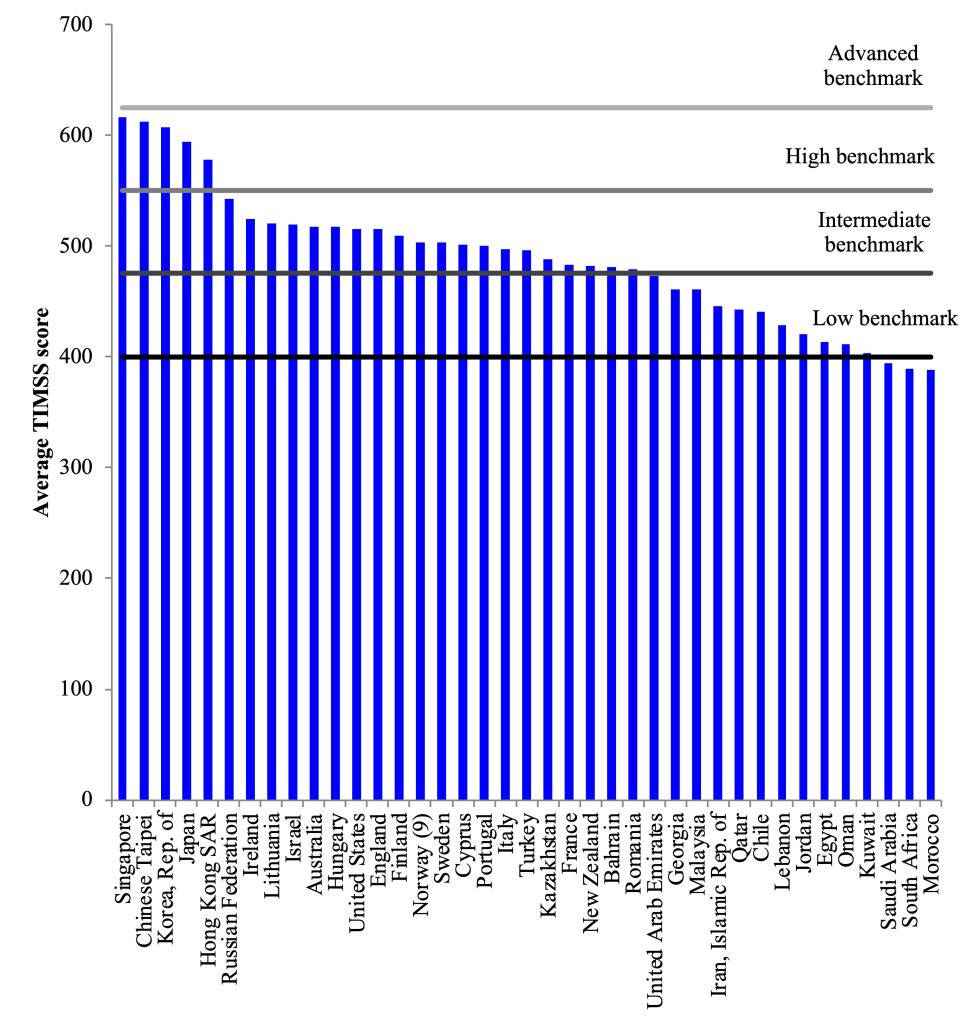
Global development goals for education
The progress in expanding enrollments, coupled with the deficit in learning, has been reflected in global development goals for education. In 1990, the international community committed to Education for All, a principle subsequently updated in 2000 to expand access, reduce inequality, and improve quality in education.[15] The first set of global development goals were the Millennium Development Goals (MDGs), approved in 2000, which set targets for 2015. One of the goals of the MDGs was universal primary education (UPE), ensuring every child completes primary. These goals often framed education as a human right—but primarily focused on access to education, not its quality. The MDGs were replaced in 2015 by the Sustainable Development Goals (SDGs), goals to achieve by 2030.[16] The SDGs shifted the focus from enrollment to learning. For example, one of the indicators for the SDGs is the proportion of children in grade 2 or 3 who have achieved minimum proficiency in reading—one of the deficits shown in Figure 7.4.
How do families and societies make decisions about education?
To unlock the potential of education, we need to understand how education decisions are made, before we can think about policies that might change the current landscape. We will first examine the way families make decisions about education. Then we will examine why society might want to have different levels of education than families would choose on their own.
Supply and demand for education in a private market
The typical model for the market for a good or service is supply and demand. A supply and demand model of the “market” for education will be our starting point for understanding the economics of education. Figure 7.6 shows supply and demand for education in Peru, where the currency is the Peruvian sol. We are starting with a case of just a private market for education. In this private market, families pay tuition each year in Peruvian sol. How many years of school they will buy at each tuition rate is shown by the demand curve. You can think of this as the case for an “average” or “representative” family. Although the idea of demand is the same as for other goods and services, in this model we delve a bit deeper into what demand is. Although families may get some enjoyment out of education, a major motivation for sending kids to school is the benefit of school. One of those benefits, earning higher wages as an adult, is called the return to education. Globally, the return to education is an approximately 9% increase in wages for each additional year of school.[17]
Since demand is based on the benefits of education—whether enjoyment or wages—we can rename the demand curve to be the marginal private benefit (MPB). The benefit is “private” in the sense that the family decides how much education to demand based on their benefits—not the benefits to society. Demand, as is typical, increases as the price of schooling drops. Since we know that demand is affected by a variety of factors, such as income, different families are likely to have different demand depending on their income, preferences, expectations for the future, or alternatives for their children. For example, families may have lower demand for formal schooling when alternatives such as apprenticeships are more lucrative.[18] Demand will also depend on the quality of schooling. Students are likely to drop out earlier when education quality is poor.[19]
We can now rename supply to be the marginal private cost (MPC). Since we are operating (for the moment) in a world with a purely private market, you can think of for-profit schools deciding how much to charge for different amounts of schooling. The MPC rises with years of schooling because it is more expensive to deliver additional education; teacher’s wages must be raised to attract more teachers, more schools must be built in remote locations, and at higher levels teachers need more qualifications and training. Thus, supply is upward sloping. Supply here is related to the usual factors, including input costs (for example, teachers and textbooks).
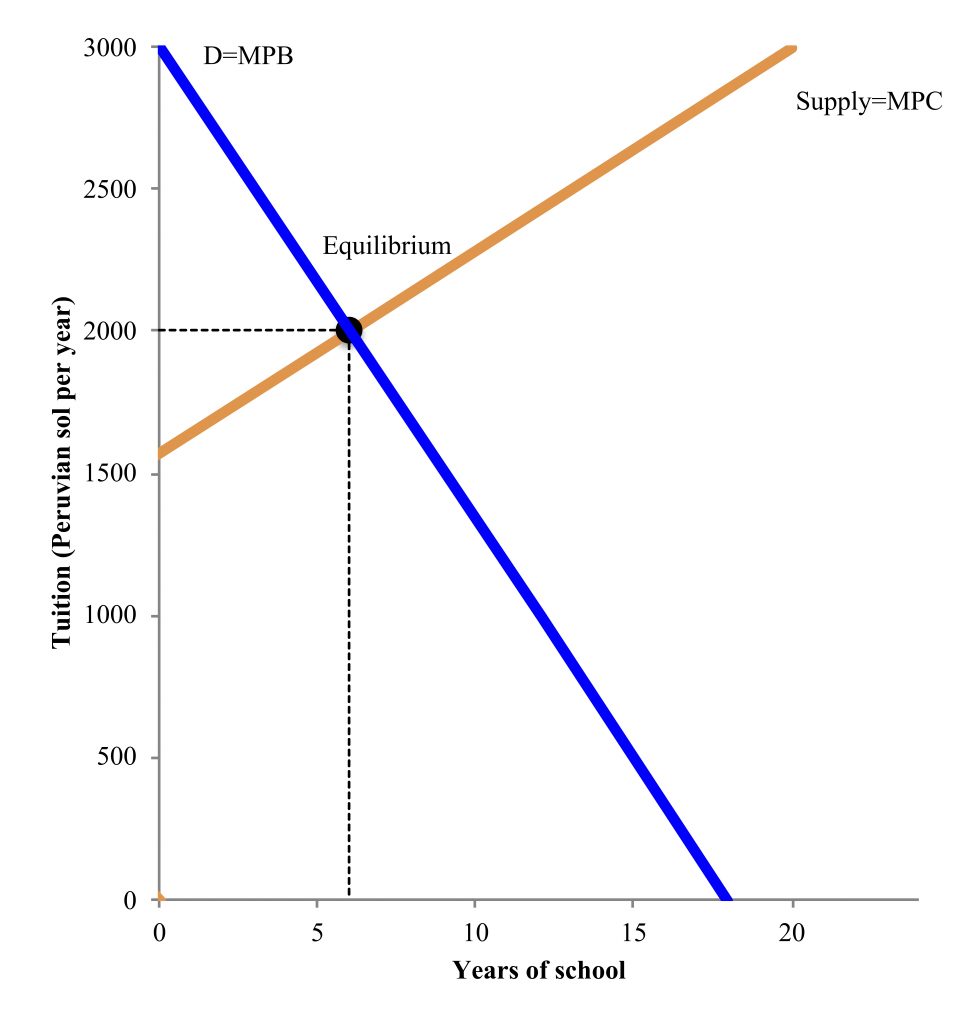
In the example in Figure 7.6, the education outcome that occurs is determined by equilibrium, where D=S or MPB=MPC. In this example, equilibrium is six years of school costing 2,000 sol per year. As the next section shows, although this is the equilibrium, it is not necessarily efficient.
Why the private market is inefficient
There are a number of reasons the private market in education is not efficient. First, families are making decisions for their children about education. Parents pay the costs: tuition, as well as the opportunity cost of children’s time taken away from other activities, such as the family business or caring for siblings. Parents do not receive all the benefits of education. They will not be the ones receiving additional future income, their children will. In contexts where girls are more likely to die, less likely to work, where girls earn less, or where girls leave the family or community at marriage, families will receive lower benefits for girls’ education than boys’ education. As a result, there will be lower demand for girls’ education and gender inequality.[20]
Not only do benefits often accrue to children rather than their families, but also some benefits of education go to neither the children receiving the education nor their families. Benefits of education include improved health for the educated individual’s children.[21] Especially since women disproportionately care for the next generation, this benefit is greater for educating girls than for boys. However, it is not a private benefit. This benefit is an externality, also called a spillover, specifically an externality in consumption. An externality in consumption occurs when the person consuming (demanding) a good does not receive the full benefits[22] of that good. When a girl going to school improves her future children’s health, this is an externality in consumption. The benefits to society of reduced crime, increased political participation, and reduced intergenerational inequality are just a few of the externalities to education. These externalities are additional benefits on top of the direct, private benefits to families.
Figure 7.7 incorporates the externalities that occur in education into our supply and demand model. The externalities in education are benefits added to the MPB. The MPB the externality is what we call the marginal social benefit (MSB). MSB is the total benefit to society, including to the individual, his or her family, and society as a whole. For now, we are going to assume that marginal private costs and marginal social costs (MSC) are the same. We will revisit that assumption in the next chapter, when we examine pollution. We can now define a new concept: the social optimum, where the MSB=MSC. On Figure 7.7, this point is ten years of school at a cost of 2,285 sol. This is the point where the benefits to society are equal to the costs. The social optimum is efficient for society, because if there were more education than ten years, the costs would exceed the social benefits. If there were less than ten years of schooling, for instance the six at the equilibrium, there would be unrealized benefits that would be worth additional investment in schooling—up to ten years.
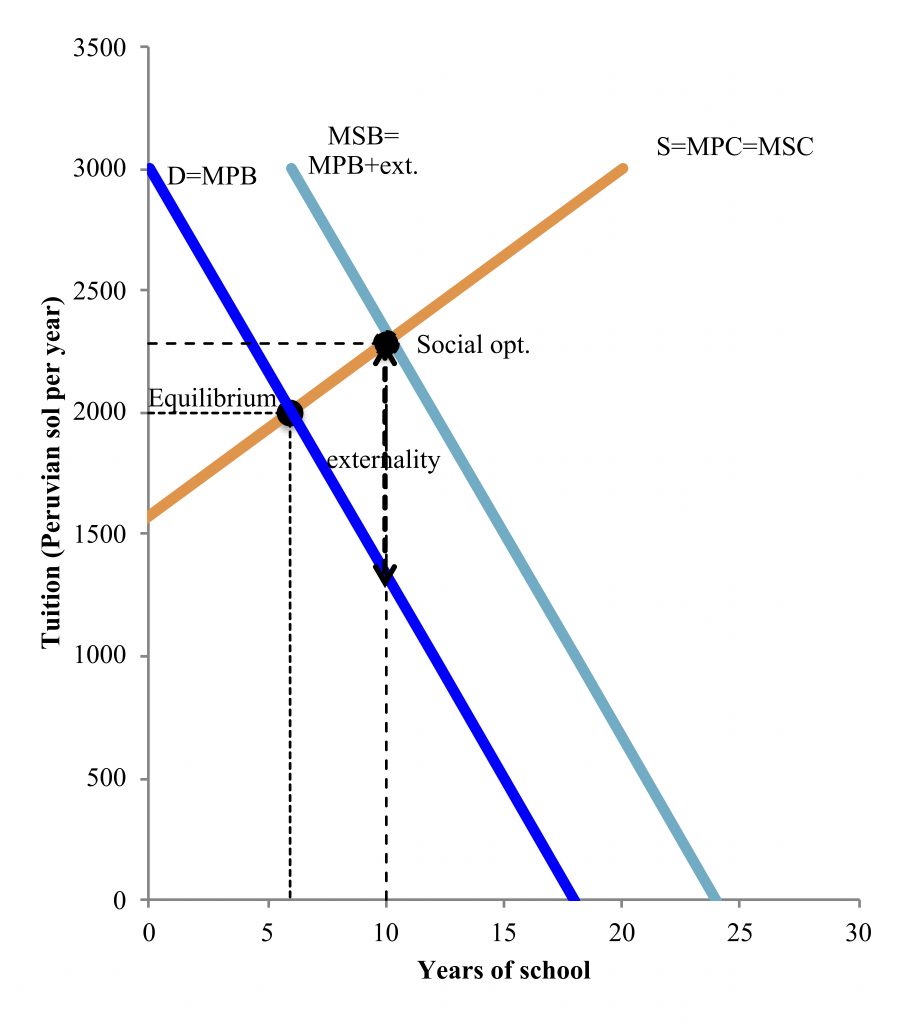
In a market without externalities, such as that for wheat, from Chapter 2, the market equilibrium is efficient and socially optimal. For education, because of the externality, the market equilibrium is inefficient. Cases where the market equilibrium is inefficient are referred to as market failures. Public goods, discussed in the crime chapter, are another example of market failures, where the private market will not provide the efficient or optimal amount of a good or service.
In Figure 7.7, the externality is shown as a constant additional 952 sol worth of benefits to society. It is, however, entirely possible that the externality varies by level of education (the MSB line may not be parallel to MPB). Private benefits may also vary by education (the MPB line may not be straight). For example, researchers have argued the return to investing in pre-primary education is higher than for other levels.[23] One study of the impact of a pre-primary education program on disadvantaged children in Chicago found that the benefit of investing in the preschool program was $74,981 for $7,384 of average costs, a benefit/cost ratio of $10.15.[24] Most of the benefit was an externality, benefits to society beyond those to individuals, specifically $6.87 of the $10.15 benefit/cost ratio. Externalities can be very large—but they are difficult to measure and quantify.
How can policy help solve education market failures?
Now that we know how and why the private market fails to deliver a socially optimal level of education, we can better understand the role of the public sector in education, and in particular different potential approaches to addressing the externality. Our goal with these policies is to achieve the socially optimal level of education.
Subsidizing education
The first approach we will consider for education is one of subsidizing education. A subsidy reduces the cost of a good or service, by the government paying for part of that cost. A subsidy does not mean a good is free, just that its price is lower for consumers. The government must pay the difference between what suppliers receive and what consumers pay. Figure 7.8 shows how an education subsidy would work for education in Peru. The government must pay the amount of the externality—the gap between the social optimum (MSB) and MPB. Since the amount of the externality is 952 sol and the MPC(=MSC) is 2,285 sol per year for 10 years of school, the subsidized price will be 1,333 sol (=2,285-952). At this price, families will choose to consume ten years of school based on their demand (MPB). An education subsidy will achieve the social optimum, so long as the government knows the size of the externality and sets the subsidy accordingly.
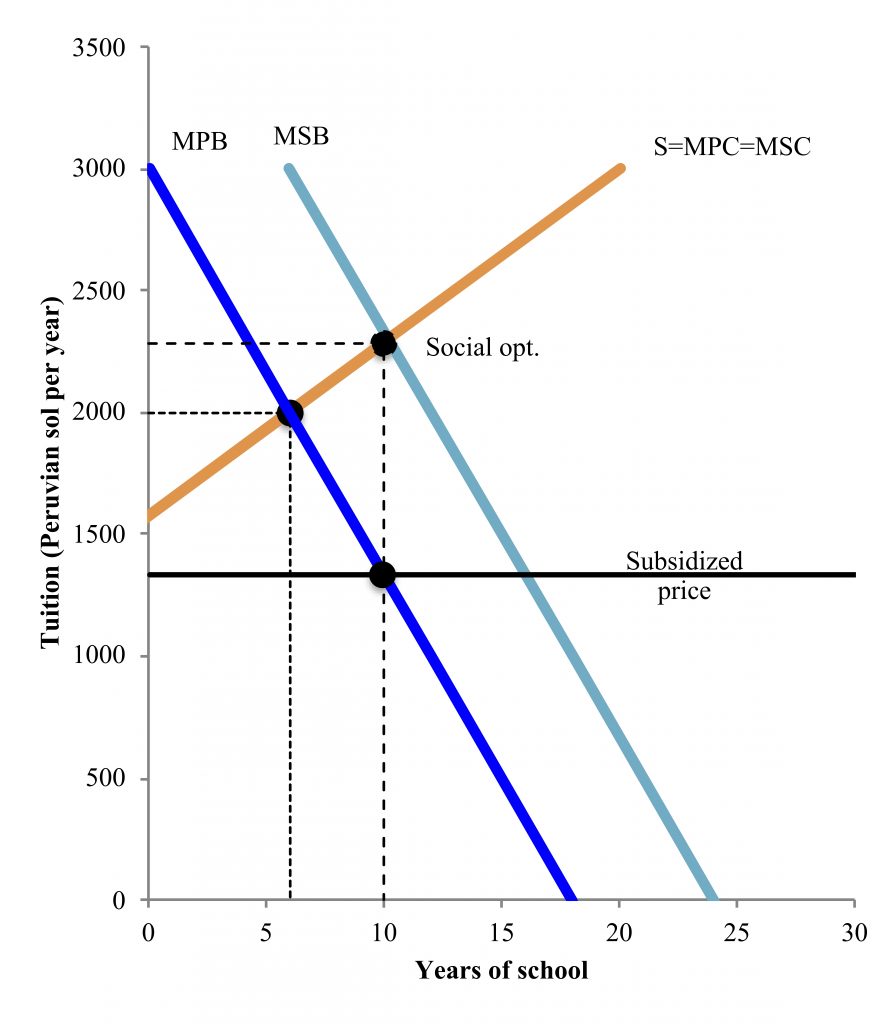
Free education
Countries do subsidize education, but more commonly, they offer education free of charge. Figure 7.9 analyzes the economic results of free education in Peru. With our assumptions about the externality, we know that the socially optimal level of education is ten years of school. When the price of school is lowered to zero for families, they will still choose the quantity where the price equals their demand (MPB). In this example, at a price of zero, families demand 18 years of school (all the way through six years of primary, six years of secondary, four years of university, and two years of a master’s degree). Although this education is free to families, it is not free to society. Society has to pay 2,857 sol per year, for 18 years. Free education is not socially optimal in this case; it is inefficient. For years past ten, the additional years of schooling have social benefits that are less than their costs.
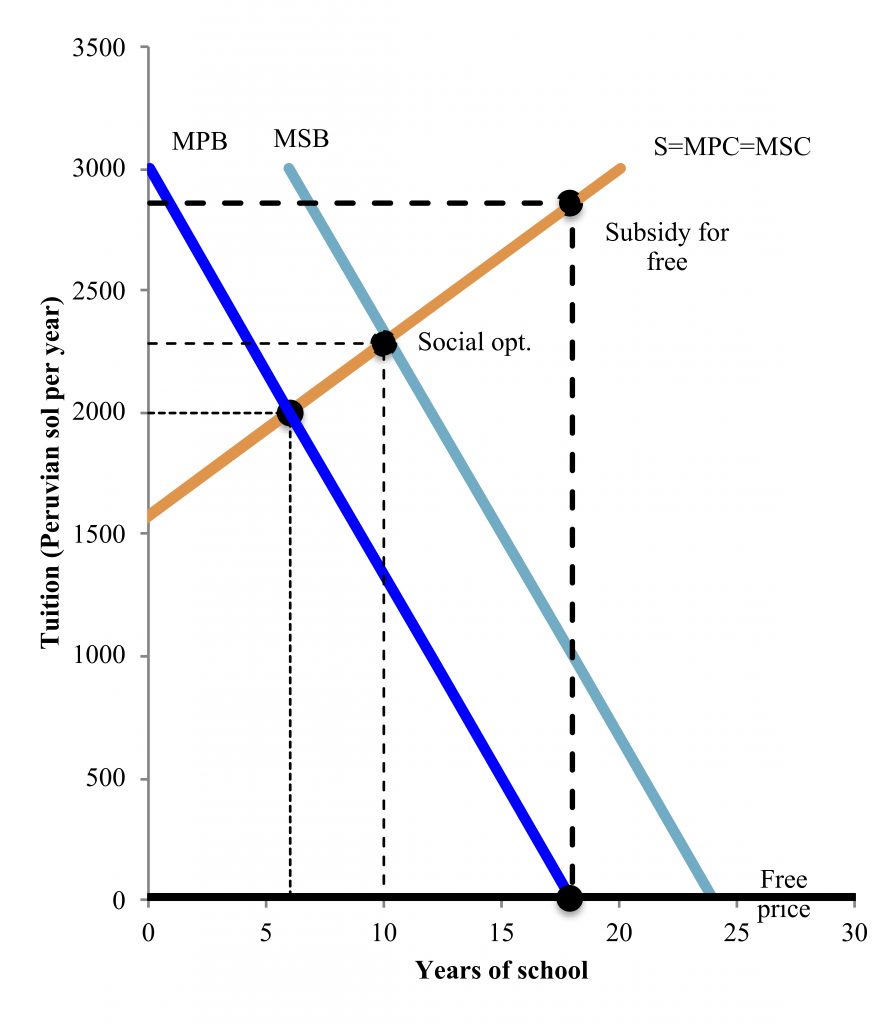
If free schooling is inefficient, as Figure 7.9 suggests, why is it so common to have free education? One reason is that we do not actually know the exact, total size of all the externalities to education. It is entirely possible the externalities are so large that free education would lead to (close) to the social optimum. It may also make sense to make certain levels of education free. In this case for Peru, although society would bear the costs rather than families, free education through grade 10 (age 16) would lead to the optimal amount of education. Society would have to fund this education through taxes, but it might be more politically feasible to have compulsory (required) free education through age 16 financed by taxes. A similar argument could be made for free education past compulsory schooling if the private benefits could be recouped through taxes on additional wages that result from education. Although directly taxing graduates of education is not common, it is another potential approach to funding education.[25]
Separating education financing from education provision
In the preceding discussion, we did not specify who provided education. Although there is a strong economic argument for subsidizing education, that does not (necessarily) mean that the public sector has to provide education. However, publicly provided education is the norm for many countries, including the United States. Figure 7.10[26] shows public and private institutions’ spending on education as a percentage of GDP in the U.S. There was a substantial increase from the 1950s through 1970s for both public and private spending. Yet, public institutions remain dominant, at 5% of GDP, compared to 1% for private institutions.
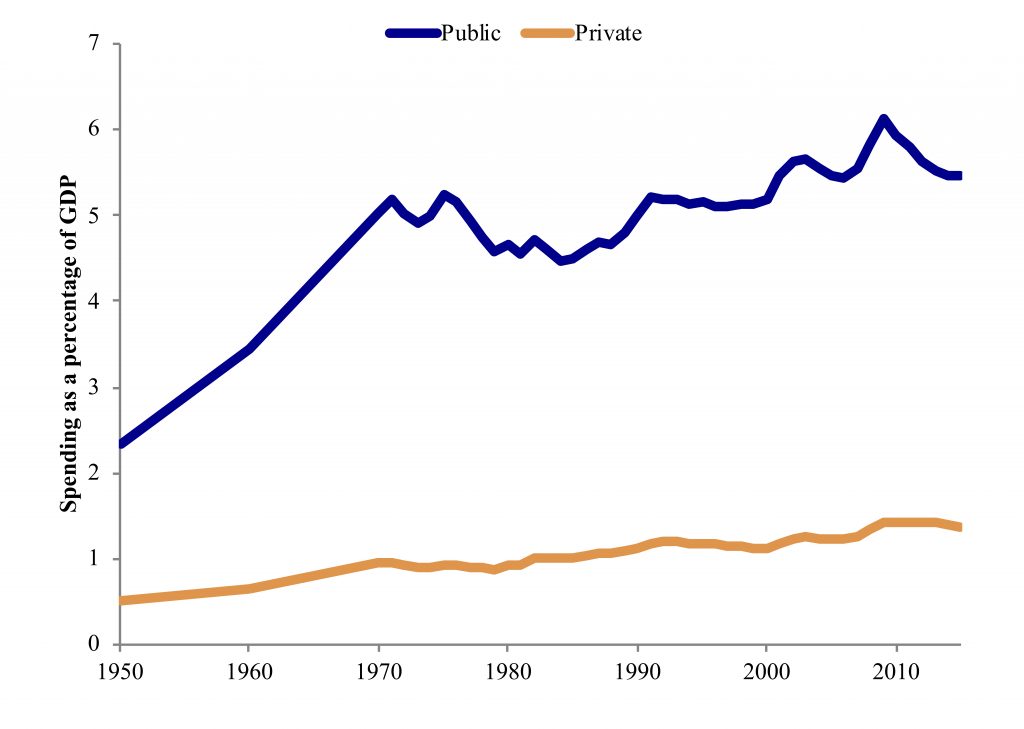
Is public provision of education the best option? Public financing can, potentially, co-exist with private provision of education. For example, school vouchers are public funding that can be used in (participating) private schools to pay for education. Charter schools are publicly-funded but privately-run schools. They typically have more flexible regulations than standard public schools. School vouchers and charter schools are part of what is referred to as “school choice.” The arguments in favor of school choice are that more choice makes families happier, that more options foster competition that improves all schools, and that private providers are better. The second two arguments can be assessed empirically. First, although some research from the U.S. and abroad suggests that having additional school options can improve educational outcomes, including learning, this result is hotly contested and not a consistent or consensus finding.[27] Policy design, such as having high standards, may be particularly important.[28]
Second, whether private providers are better or worse, in terms of costs, quality, or equity, is uncertain.[29] There are major tradeoffs that occur in private provision. An experiment with school vouchers in Louisiana, which targeted low-income students in low-performing schools, allowed numerous students to enroll in private schools. Initial effects on learning were negative, although in the long run the differences were not statistically significant.[30] Liberia recently began an experiment with a number of private providers (and public funding) for its education system. Although learning improved, the costs were also higher than public schools, and varied substantially across different private providers.[31] Two of my papers, examining higher education in Egypt and Jordan, showed that private higher education was no better (and no worse) in terms of either quality or labor market outcomes.[32] School choice can, potentially, worsen racial segregation.[33]
Inequalities exacerbated through education financing
In addition to debates about public versus private funding and provision of education, there are important debates around how schools are publicly funded and what that means for equality. Figure 7.11[34] shows how the United States funds public schools, specifically the percentage of GDP that goes towards schools from local, state, and federal sources. Historically, funding for schools was predominantly local, but since the 1970s there have been equal local and state shares in overall funding (around 2% each in 2010). Federal funding remains very low, less than 1%. Local funding in particular may contribute to inequality.[35] When children live in low-income communities, they will already be at a disadvantage due to community poverty (and often family poverty as well). When local property taxes fund their schools, and the tax base that votes on school matters has lower income and lower property values, schools will be underfunded. Local property taxes as the basis for school funding translate into students already at risk for poorer outcomes attending schools with fewer resources and lower quality. Although state and federal policies may direct some money towards low-income schools or children, spending is not equal, much less learning. Spending equalization has the potential to narrow test score gaps that depend on family background.[36] Box 7.1 discusses another idea, “baby bonds” targeted to low-income families.
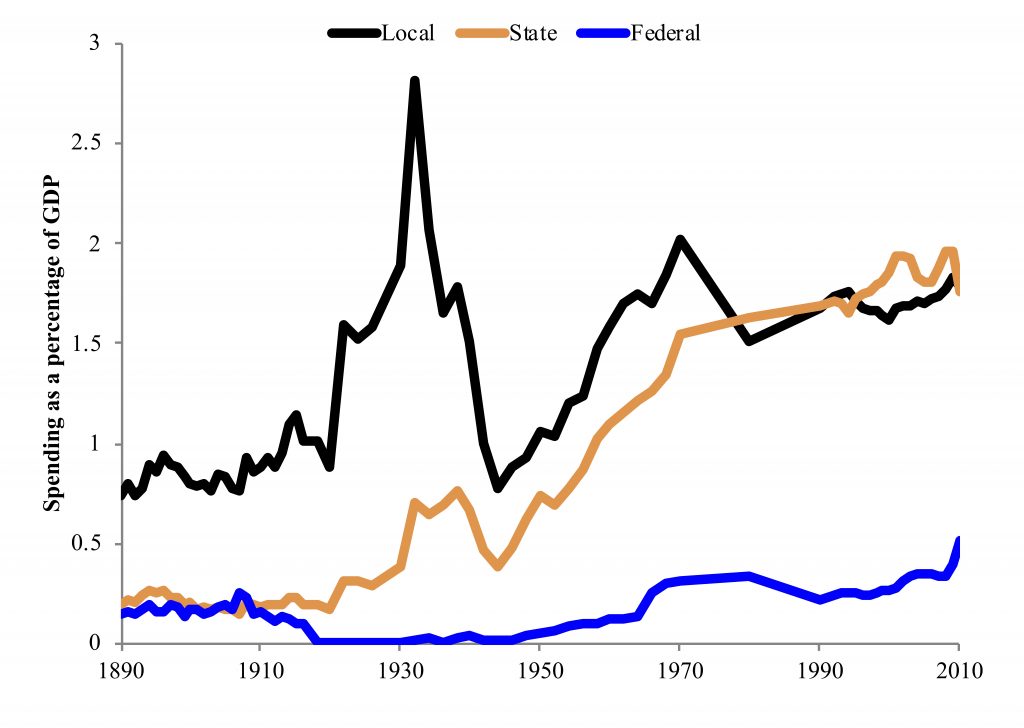
Box 7.1. Economists in action: William Darity, Jr. and Darrick Hamilton propose “baby bonds”[37]
What works to improve education?
What works to improve education? This section examines two key issues in education: enrollment and learning. Distinct interventions work for these different challenges, however, interventions tend to be one of a few different types: resources (money, school buildings, more teachers, etc.), pedagogy (how teachers teach), incentives (how schools are managed, how teachers are evaluated and paid), or supporting students’ well-being (lunch programs, school nurses, etc.).
Enrollment and Attendance
Once a local school exists (a key prerequisite!), what helps families enroll their children in school and children attend school? Family resources are particularly important for enrollment. Especially in contexts (families or countries) where income is a major constraint on enrollment, cash transfers can be very effective for increasing enrollment.[38] Transfers may be conditioned on attending education, but there are also benefits to unconditional transfers. In contexts where enrollment is low and food security is particularly a challenge, school feeding programs (meals eaten at school or taken home from school) improve enrollment.[39] Not every resource makes a difference in ensuring attendance. For example, policy makers had identified menstruation (a girl having her period) and lack of sanitary products as a barrier to girls’ schooling. However, a study in Nepal showed menstruation had little impact on attendance and a random experiment giving out sanitary products had no effect on attendance.[40]
Learning
What improves learning when students are in school? Cash transfers are not effective for improving learning (although they help with enrollment).[41] Educational technology, such as giving a laptop to every student (“one laptop per child”) may sound promising, but is not effective.[42] Narrower applications of education technology are more effective. Specifically, computer-adaptive technology for math, where questions are adjusted and explanations offered at the student’s current level, does improve learning.[43] Reducing class size can improve learning, particularly in early grades, but is also costly.[44]
When it comes to learning, pedagogy is particularly important. Teaching at the right level (addressing children where they are at, rather than adhering to the official curriculum) causes substantial gains in learning.[45] Remedial tutoring, particularly in addition to regular school, rather than as a substitute, can help children who have fallen behind catch up.[46] Teacher training, so long as it is ongoing and supportive, not one-off, can help improve teachers’ skills and students’ learning.[47]
There is mixed evidence about the role of teachers’ incentives in learning. Some policy makers argue that it should be easier to hire and fire teachers, and that their pay should be based on performance. Contract teachers are less expensive and equally effective as regular civil-service teachers in India.[48] Paying teachers based on student test scores sometimes improves test scores and other times does not. Performance pay may increase “teaching to the test.” Providing stronger local control of schools (school-based management) does not consistently improve learning outcomes.[49] School-based management works better in middle-income countries when parents are more able to engage in the process.
Although the evidence suggests what interventions are likely to be more (or less) effective, an important part of addressing learning is assessing what the barriers are for a particular context or country. For example, if rigid adherence to a curriculum that leaves students behind is common, then teaching at the right level may be more effective. Therefore, as well as evaluating “what works” education economics can play a role in first evaluating “what’s the problem?”[50]
Box 7.2. Economists in action: Esther Duflo and the Poverty Action Lab[51]
Esther Duflo is a Professor of Poverty Alleviation and Development Economics at the Massachusetts Institute of Technology (MIT). She got her undergraduate degrees in History and Economics at Ecole Normale Superieure, Paris and her PhD in Economics from MIT. While working at MIT, she cofounded (and currently co-directs) the Abdul Latif Jameel Poverty Action Lab (J-PAL), which undertakes evaluations of programs to reduce poverty—including in the education sector.
Dr. Duflo has studied education topics such as the expansion of education in Indonesia, the impact of remedial education on learning in India, and the impact of cash transfers for education on enrollment in Morocco. She has been particularly prominent in increasing the role of impact evaluations—to figure out what works and why—in development economics. Her innovative work earned her the Nobel Prize in Economics, along with Abhijit Banerjee and Michael Kremer.
Summary and conclusions
Education has enormous potential to improve individuals’ well-being and countries’ development. Education benefits individuals, who earn more as they learn more. However, education also has externalities, spillovers that benefit society as a whole. Due to externalities in education, it is inefficient to leave education to private markets alone—education will be under-provided. The public sector must intervene to ensure there is enough education. Whether the public sector should provide, as well as fund, education is a hotly debated issue. The balance of evidence is that private provision will not be sufficient for improving education access, quality, or equality. A growing body of research indicates what policies are more (or less) likely to work in education, but much more research is needed to ensure education achieves its full potential.
List of terms
- Literacy
- Literacy
- Enrollment
- Gross enrollment ratio
- Education for All
- Millennium Development Goals (MDGs)
- Universal Primary Education (UPE)
- Sustainable Development Goals (SDGs)
- Return to education
- Marginal Private Benefit (MPB)
- Marginal Private Cost (MPC)
- Externality
- Externality in consumption
- Marginal Social Benefit (MSB)
- Marginal Social Cost (MSC)
- Social optimum
- Market failure
- Subsidy
- School voucher
- Charter school
References
Alderman, Harold, and Donald Bundy. “School Feeding Programs and Development: Are We Framing the Question Correctly?” World Bank Research Observer 27, no. 2 (2012): 204–21. doi:10.1093/wbro/lkr005.
Ali, Fatma Romeh M., and Shiferaw Gurmu. “The Impact of Female Education on Fertility: A Natural Experiment from Egypt.” Review of Economics of the Household 16, no. 3 (2018): 681–712. doi:10.1007/s11150-016-9357-6.
Alves, Fatima, Gregory Elacqua, Mariane Koslinki, Matias Martinez, Humberto Santos, and Daniela Urbina. “Winners and Losers of School Choice: Evidence from Rio de Janeiro, Brazil and Santiago, Chile.” International Journal of Educational Development 41 (2015): 25–34. doi:10.1016/j.ijedudev.2014.12.004.
Anand, Priyanka, Alejandra Mizala, and Andrea Repetto. “Using School Scholarships to Estimate the Effect of Private Education on the Academic Achievement of Low-Income Students in Chile.” Economics of Education Review 28 (2009): 370–81. doi:10.1016/j.econedurev.2008.03.005.
Angrist, Joshua D ., and Victor Lavy. “Using Maimonides ’ Rule to Estimate the Effect of Class Size on Scholastic Achievement.” Quarterly Journal of Economics 114, no. 2 (1999): 533–75.
Ashley, Laura Day, Claire Mcloughlin, Monazza Aslam, Jakob Engel, Joseph Wales, Shenila Rawal, Richard Batley, Geeta Kingdon, Susan Nicolai, and Pauline Rose. “Education Rigorous Literature Review: The Role and Impact of Private Schools in Developing Countries.” Department for International Development, 2014.
Aslam, Monazza. “Education Gender Gaps in Pakistan: Is the Labor Market to Blame?” Economic Development and Cultural Change 57, no. 4 (2009): 747–84.
Aslam, Monazza, Shenila Rawal, and Sahar Saeed. “Public-Private Partnerships in Education in Developing Countries: A Rigorous Review of the Evidence.” Ark, 2017.
Assaad, Ragui, Eslam Badawy, and Caroline Krafft. “Pedagogy, Accountability, and Perceptions of Quality by Type of Higher Education in Egypt and Jordan.” Comparative Education Review 60, no. 4 (2016): 746–75.
Assaad, Ragui, Caroline Krafft, and Djavad Salehi-Isfahani. “Does the Type of Higher Education Affect Labor Market Outcomes? Evidence from Egypt and Jordan.” Higher Education 75, no. 6 (2018): 945–95. doi:10.1007/s10734-017-0179-0.
Assaad, Ragui, and Mohamed Saleh. “Does Improved Local Supply of Schooling Enhance Intergenerational Mobility in Education? Evidence from Jordan.” World Bank Economic Review 3, no. 1 (2018): 633–55. https://doi.org/10.1093/wber/lhw041.
Banerjee, Abhijit, Rukmini Banerji, James Berry, Esther Duflo, Harini Kannan, Shobhini Mukerji, Marc Shotland, and Michael Walton. “Mainstreaming an Effective Intervention: Evidence From Randomized Evaluations of ‘Teaching At the Right Level’ in India.” NBER Working Paper Series, 2016.
Banerjee, Abhijit V., Shawn Cole, Esther Duflo, and Leigh Linden. “Remedying Education: Evidence from Two Randomized Experiments in India.” The Quarterly Journal of Economics 122, no. 3 (2007): 1235–64. http://qje.oxfordjournals.org/content/122/3/1235.short.
Bates, Mary Ann, and Rachel Glennerster. “The Generalizability Puzzle.” Stanford Social Innovation Review, 2017.
Benhassine, Najy, Florencia Devoto, Esther Duflo, Pascaline Dupas, and Victor Pouliquen. “Turning a Shove into a Nudge? A ‘Labeled Cash Transfer’ for Education.” American Economic Journal: Economic Policy 7, no. 3 (2015): 1–48. doi:10.1257/pol.20130225.
Biasi, Barbara. “School Finance Equalization Increases Intergenerational Mobility: Evidence from a Simulated-Instruments Approach.” NBER Working Paper Series, 2021.
Breierova, Lucia, and Esther Duflo. “The Impact of Education on Fertility and Child Mortality: Do Fathers Really Matter Less than Mothers?” NBER Working Paper. Cambridge, MA, 2004. http://www.nber.org/papers/w10513.
Card, David, and A. Abigail Payne. “School Finance Reform, the Distribution of School Spending, and the Distribution of Student Test Scores.” Journal of Public Economics 83, no. 1 (2002): 49–82. doi:10.1016/S0047-2727(00)00177-8.
Carr-Hill, Roy, Caine Rolleston, Tejendra Pherali, and Rebecca Schendel. “The Effects of School-Based Decision Making on Educational Outcomes in Low- and Middle-Income Contexts: A Systematic Review.” Campbell Systematic Reviews, 2016.
Celhay, Pablo, and Sebastian Gallegos. “Persistence in the Transmission of Education: Evidence across Three Generations for Chile.” Journal of Human Development and Capabilities 16, no. 3 (2015): 420–51. doi:10.1080/19452829.2015.1048789.
Chou, Shin-Yi, Jin-Tan Liu, Michael Grossman, and Ted Joyce. “Parental Education and Child Health: Evidence from a Natural Experiment in Taiwan.” American Economic Journal: Applied Economics 2, no. 1 (2012): 581–86. doi:10.1007/s11145-010-9260-0.How.
Chudgar, Amita, and Elizabeth Quin. “Relationship between Private Schooling and Achievement: Results from Rural and Urban India.” Economics of Education Review 31, no. 4 (2012): 376–90. doi:10.1016/j.econedurev.2011.12.003.
Cristia, Julian P., Pablo Ibarraran, Santiago Cueto, Ana Santiago, and Eugenio Severin. “Technology and Child Development: Evidence from the One Laptop per Child Program.” IDB Working Paper Series, 2012.
Currie, Janet, and Enrico Moretti. “Mother’s Education and the Intergenerational Transmission of Human Capital: Evidence from College Openings.” The Quarterly Journal of Economics 118, no. 4 (2003): 1495–1532. doi:10.1162/003355303322552856.
Darity Jr., William A., Darrick Hamilton, and James B. Stewart. “A Tour de Force in Understanding Intergroup Inequality: An Introduction to Stratification Economics.” Review of Black Political Economy 42 (2015): 1–6. doi:10.1007/s12114-014-9201-2.
Dee, Thomas S. “Are There Civic Returns to Education?” Journal of Public Economics 88, no. 9–10 (2004): 1697–1720. doi:10.1016/j.jpubeco.2003.11.002.
Dinçer, Mehmet Alper, Neeraj Kaushal, and Michael Grossman. “Women’s Education: Harbinger of Another Spring? Evidence from a Natural Experiment in Turkey.” World Development 64, no. 2010 (2014): 243–58. doi:10.1016/j.worlddev.2014.06.010.
Duflo, Esther. “Esther Duflo Banquet Speech.” The Nobel Prize, 2019. https://www.nobelprize.org/prizes/economic-sciences/2019/duflo/speech/.
———. “Schooling and Labor Market Consequences of School Construction in Indonesia: Evidence from an Unusual Policy Experiment.” American Economic Review 91, no. 4 (2000): 795–813. http://www.nber.org/papers/w7860.
Dursun, Bahadır, and Resul Cesur. “Transforming Lives: The Impact of Compulsory Schooling on Hope and Happiness.” Journal of Population Economics 29, no. 3 (2016): 911–56. doi:10.1007/s00148-016-0592-1.
Escueta, Maya, Vincent Quan, Andre Joshua Nickow, and Philip Oreopoulous. “Education Technology: An Evidence-Based Review.” NBER Working Paper Series, 2017.
Fennell, Shailaja, and Rabea Malik. “Between a Rock and a Hard Place: The Emerging Educational Market for the Poor in Pakistan.” Comparative Education 48, no. 2 (2012): 249–61. doi:10.1080/03050068.2011.608900.
Ferreyra, Maria Marta, and Grigory Kosenok. “Charter School Entry and School Choice: The Case of Washington, D.C.” Journal of Public Economics 159 (2018): 160–82. doi:10.1016/j.jpubeco.2017.12.008.
Friedman, Willa, Michael Kremer, Edward Miguel, and Rebecca Thornton. “Education as Liberation?” Economia 83, no. 329 (2016): 1–30.
García-Peñalosa, Cecilia, and Klaus Wälde. “Efficiency and Equity Effects of Subsidies to Higher Education.” Oxford Economic Papers 52, no. 4 (2000): 702–22.
Gitter, Seth R., and Bradford L. Barham. “Women’s Power, Conditional Cash Transfers, and Schooling in Nicaragua.” World Bank Economic Review 22, no. 2 (2008): 271–90. doi:10.1093/wber/lhn006.
Glewwe, Paul. “Why Does Mother’s Schooling Raise Child Health in Developing Countries? Evidence from Morocco.” Journal of Human Resources 34, no. 1 (1999): 124–59.
Glewwe, Paul, Nauman Ilias, and Michael Kremer. “Teacher Incentives.” American Economic Journal: Applied Economics 2, no. 3 (2010): 205–27.
Hamilton, Darrick, and William Darity Jr. “Can ‘Baby Bonds’ Eliminate the Racial Wealth Gap in Putative Post-Racial America?” Review of Black Political Economy 37 (2010): 207–16. doi:10.1007/s12114-010-9063-1.
Härmä, Joanna. “Access or Quality? Why Do Families Living in Slums Choose Low-Cost Private Schools in Lagos, Nigeria?” Oxford Review of Education 39, no. 4 (2013): 548–66. doi:10.1080/03054985.2013.825984.
———. “Ensuring Quality Education? Low-Fee Private Schools and Government Regulation in Three Sub-Saharan African Capitals.” International Journal of Educational Development 66 (2019): 139–46. doi:10.1016/j.ijedudev.2018.10.007.
———. “School Choice in Rural Nigeria? The Limits of Low-Fee Private Schooling in Kwara State.” Comparative Education 52, no. 2 (2016).
Heckman, James J. “Skill Formation and the Economics of Investing in Disadvantaged Children.” Science 312, no. 5782 (June 30, 2006): 1900–1902. doi:10.1126/science.1128898.
Henig, Jeffrey R. Rethinking School Choice: Limits of the Market Metaphor. Princeton University Press, 1995.
Hoxby, Caroline M. “Does Competition Among Public Schools Benefit Students and Taxpayers?” The American Economic Review 90, no. 5 (2000): 1209–38.
Jayachandran, Seema. “The Roots of Gender Inequality in Developing Countries.” Annual Review of Economics 7 (2015): 63–88. doi:10.1146/annurev-economics-080614-115404.
Jayachandran, Seema, and Adriana Lleras-Muney. “Life Expectancy and Human Capital Investments: Evidence from Maternal Mortality Declines.” Quarterly Journal of Economics 124, no. 1 (2009): 349–97.
Kerwin, Jason T., and Rebecca Thornton. “Making the Grade: The Sensitivity of Education Program Effectiveness to Input Choices and Outcome Measures.” The Review of Economics and Statistics, 2020, 1–45. doi:10.1162/rest_a_00911.
Krafft, Caroline. “Is School the Best Route to Skills? Returns to Vocational School and Vocational Skills in Egypt.” The Journal of Development Studies 54, no. 7 (2018): 1100–1120. doi:10.1080/00220388.2017.1329524.
Lai, Fang, Linxiu Zhang, Xiao Hu, Qinghe Qu, Yaojiang Shi, Yajie Qiao, Matthew Boswell, and Scott Rozelle. “Computer Assisted Learning as Extracurricular Tutor? Evidence from a Randomised Experiment in Rural Boarding Schools in Shaanxi.” Journal of Development Effectiveness 5, no. 2 (2013): 208–31. doi:10.1080/19439342.2013.780089.
Lee, Jong-wha, and Hanol Lee. “Human Capital in the Long Run.” Journal of Development Economics 122 (2016): 147–69. doi:10.1016/j.jdeveco.2016.05.006.
Lleras-Muney, Adriana. “The Relationship between Education and Adult Mortality in the United States.” Review of Economic Studies 72 (2002): 189–221.
Lloyd, Cynthia B., Sahar El Tawila, Wesley H. Clark, and Barbara S. Mensch. “The Impact of Educational Quality on School Exit in Egypt.” Comparative Education Review 47, no. 4 (2003): 444–67. http://www.jstor.org/stable/10.1086/378247.
Lochner, Lance, and Enrico Moretti. “The Effect of Education on Crime: Evidence from Prison Inmates, Arrest, and Self-Reports.” American Economic Review 94, no. 1 (2004): 155–89. doi:10.1257/000282804322970751.
Massachusetts Institute of Technology. “Esther Duflo Short Bio,” 2017. https://economics.mit.edu/faculty/eduflo/short.
Milligan, Kevin, Enrico Moretti, and Philip Oreopoulos. “Does Education Improve Citizenship? Evidence from the United States and the United Kingdom.” Journal of Public Economics 88, no. 9–10 (2004): 1667–95. doi:10.1016/j.jpubeco.2003.10.005.
Mills, Jonathan N., and Patrick J. Wolf. “The Effects of the Louisiana Scholarship Program On Student Achievement after Three Years.” Education Research Alliance for New Orleans, 2017. doi:10.2139/ssrn.2738805.
Mocan, Naci H., and Colin Cannonier. “Empowering Women Through Education: Evidence from Sierra Leone.” National Bureau of Economic Research Working Paper Series, 2012. doi:10.3386/w18016.
Mullis, I. V. S., M. O. Martin, P. Foy, D. L. Kelly, and B. Fishbein. “TIMSS 2019 International Results in Mathematics and Science.” Boston College TIMSS & PIRLS International Study Center, 2020.
Muralidharan, Karthik, Abhijeet Singh, and Alejandro J. Ganimian. “Disrupting Education? Experimental Evidence on Technology-Aided Instruction in India,” 2017.
Muralidharan, Karthik, and Venkatesh Sundararaman. “Contract Teachers: Experimental Evidence from India.” NBER Working Paper Series. Cambridge, MA, 2013. http://www.nber.org/papers/w19440.
———. “Teacher Performance Pay: Experimental Evidence from India.” Journal of Political Economy 119, no. 1 (2011): 39–77.
Nishimura, Mikiko, and Takashi Yamano. “School Choice between Public and Private Primary Schools under the Free Primary Education Policy in Rural Kenya.” World Development 43 (2013): 266–75.
Oster, Emily, and Rebecca Thornton. “Menstruation, Sanitary Products, and School Attendance: Evidence from a Randomized Evaluation.” American Economic Journal: Applied Economics 3, no. 1 (2011): 91–100.
Pal, Sarmistha, and Bibhas Saha. “Enhancing Excellence: Socially Motivated Private Schools of Nepal.” Journal of Development Studies 55, no. 5 (2019): 765–85. doi:10.1080/00220388.2018.1464142.
Plank, David Nathan, and Gary Sykes, eds. Choosing Choice: School Choice in International Perspective. Teachers College Press, 2003.
Ponce, Juan, and Arjun S. Bedi. “The Impact of a Cash Transfer Program on Cognitive Achievement: The Bono de Desarrollo Humano of Ecuador.” Economics of Education Review 29, no. 1 (2010): 116–25. doi:10.1016/j.econedurev.2009.07.005.
Popova, Anna, David K. Evans, and Violeta Arancibia. “Training Teachers on the Job What Works and How to Measure It.” World Bank Policy Research Working Paper. Washington, DC, 2016.
Popova, Anna, David K. Evans, Mary E. Breeding, and Violeta Arancibia. “Teacher Professional Development around the World: The Gap between Evidence and Practice.” World Bank Policy Research Working Paper, 2018. http://documents.worldbank.org/curated/en/349051535637296801/pdf/WPS8572.pdf.
Power, Sally, and Chris Taylor. “Social Justice and Education in the Public and Private Spheres.” Oxford Review of Education 39, no. 4 (2013): 464–79.
Psacharopoulos, George, and Harry Anthony Patrinos. “Returns to Investment in Education: A Decennial Review of the Global Literature.” World Bank Policy Research Paper. Washington, DC, 2018.
Rao, Nitya. “Aspiring for Distinction: Gendered Educational Choices in an Indian Village.” Compare: A Journal of Comparative and International Education 40, no. 2 (2010): 167–83. doi:10.1080/03057920903546021.
Romero, Mauricio, Justin Sandefur, and Wayne Aaron. “Can Outsourcing Improve Liberia’s Schools?” Center for Global Development Working Paper Series, 2017.
Roser, Max, and Esteban Ortiz-Ospina. “Financing Education.” Our World in Data, 2017. https://ourworldindata.org/financing-education.
———. “Literacy.” Our World in Data, 2018. https://ourworldindata.org/literacy.
———. “Primary and Secondary Education.” Our World in Data, 2017. https://ourworldindata.org/primary-and-secondary-education.
Rothstein, Jesse. “Does Competition among Public Schools Benefit Students and Taxpayers? Comment.” American Economic Review 97, no. 5 (2007): 2026–37.
Sala-i-Martin, Xavier, Gernot Doppelhofer, and Ronald I. Miller. “Determinants of Long-Term Growth: A Bayesian Averaging of Classical Estimates (BACE) Approach.” The American Economic Review 94, no. 4 (2004): 813–35.
Samarakoon, Shanika, and Rasyad A. Parinduri. “Does Education Empower Women? Evidence from Indonesia.” World Development 66 (2015): 428–42. doi:10.1016/j.worlddev.2014.09.002.
Schanzenbach, Diane Whitmore. “Does Class Size Matter?” National Education Policy Center Working Paper. Boulder, CO, 2014.
Siddiqui, Nadia, and Stephen Gorard. “Comparing Government and Private Schools in Pakistan: The Way Forward for Universal Education.” International Journal of Educational Research 82 (2017): 159–69.
Singh, Renu, and Colin Bangay. “Low Fee Private Schooling in India – More Questions than Answers? Observations from the Young Lives Longitudinal Research in Andhra Pradesh.” International Journal of Educational Development 39 (2014): 142–50. doi:10.1016/j.ijedudev.2014.08.004.
Sojourner, Aaron J., Elton Mykerezi, and Kristine L. West. “Teacher Pay Reform and Productivity: Panel Data Evidence from Adoptions of Q- Comp in Minnesota.” Journal of Human Resources 49, no. 4 (2014): 945–81.
Springer, Matthew G., Dale Ballou, Laura Hamilton, Vi-Nhuan Le, J.R. Lockwood, Daniel F. McCaffrey, Matthew Pepper, and Brian M. Stecher. “Teacher Pay for Performance: Experimental Evidence from the Project on Incentives in Teaching.” Nashville, TN: National Center on Performance Incentives at Vanderbilt University, 2010.
Temple, Judy A., and Arthur J. Reynolds. “Benefits and Costs of Investments in Preschool Education: Evidence from the Child–Parent Centers and Related Programs.” Economics of Education Review 26, no. 1 (2007): 126–44.
Thapa, Amrit. “Does Private School Competition Improve Public School Performance? The Case of Nepal.” International Journal of Educational Development 33, no. 4 (2013): 358–66. doi:10.1016/j.ijedudev.2012.07.004.
The Ohio State University. “Darrick Hamilton / John Glenn College of Public Affairs,” 2020. http://glenn.osu.edu/faculty/glenn-faculty/hamilton/.
UNESCO. Accountability in Education: Meeting Our Commitments: Global Education Monitoring Report. Policy Brief. Paris, France: UNESCO, 2017. doi:10.1017/CBO9781107415324.004.
———. “Education For All Global Monitoring Report 2007: Strong Foundations: Early Childhood Care and Education.” Paris, France, 2006.
Urquiola, Miguel. “Identifying Class Size Effects in Developing Countries: Evidence from Rural Bolivia.” The Review of Economcis and Statistics 88, no. 1 (2006): 171–77.
Ukanwa, Kalinda, Aziza C. Jones, and Broderick L. Jr. Turner. “School Choice Increases Racial Segregation Even When Parents Do Not Care about Race.” PNAS 119, no. 35 (2022): e2117979119.
Wedgwood, Ruth. “Education and Poverty Reduction in Tanzania.” International Journal of Educational Development 27, no. 4 (2007): 383–96. doi:10.1016/j.ijedudev.2006.10.005.
World Bank. “Learning to Realize Education’s Promise.” Washington, DC: World Bank, 2018. doi:10.1088/0960-1317/21/12/125014.
———. “World Development Indicators.” Databank, 2023.
- Sala-i-Martin, Doppelhofer, and Miller, 2004; Wedgwood, 2007. ↵
- Assaad and Saleh, 2018; Celhay and Gallegos, 2015. ↵
- Lochner and Moretti, 2004; Temple and Reynolds, 2007. ↵
- Milligan, Moretti, and Oreopoulos, 2004; Dee, 2004. ↵
- Glewwe, 1999; Chou et al., 2012; Currie and Moretti, 2003. ↵
- Ali and Gurmu, 2018; Dinçer, Kaushal, and Grossman, 2014; Breierova and Duflo, 2004; Lleras-Muney, 2002. ↵
- Mocan and Cannonier, 2012; Friedman et al., 2016; Samarakoon and Parinduri, 2015; Dursun and Cesur, 2016. ↵
- Roser and Ortiz-Ospina, 2017; Roser and Ortiz-Ospina, 2018. ↵
- Roser and Ortiz-Ospina, 2018. ↵
- World Bank, 2023. ↵
- Lee and Lee, 2016. ↵
- World Bank, 2018. ↵
- Ibid. ↵
- Mullis et al., 2020. ↵
- UNESCO, 2006. ↵
- UNESCO, 2017. ↵
- Psacharopoulos and Patrinos, 2018. ↵
- Krafft, 2018. ↵
- Lloyd et al., 2003. ↵
- Aslam, 2009; Jayachandran and Lleras-Muney, 2009; Jayachandran, 2015. ↵
- Currie and Moretti, 2003; Glewwe, 1999. ↵
- Or, as we will see in later cases, with pollution, the costs. ↵
- Heckman, June 30, 2006. ↵
- Temple and Reynolds, 2007. ↵
- García-Peñalosa and Wälde, 2000. ↵
- Roser and Ortiz-Ospina, 2017. ↵
- Rothstein, 2007; Hoxby, 2000; Thapa, 2013; Henig, 1995; Plank and Sykes, 2003; Alves et al., 2015; Anand, Mizala, and Repetto, 2009; Ashley et al., 2014; Chudgar and Quin, 2012; Fennell and Malik, 2012; Härmä, 2019; Härmä, 2013; Härmä, 2016; Nishimura and Yamano, 2013; Pal and Saha, 2019; Power and Taylor, 2013; Rao, 2010; Siddiqui and Gorard, 2017; Singh and Bangay, 2014. ↵
- Ferreyra and Kosenok, 2018. ↵
- Aslam, Rawal, and Saeed, 2017. ↵
- Mills and Wolf, 2017. ↵
- Romero, Sandefur, and Aaron, 2017. ↵
- Assaad, Badawy, and Krafft, 2016; Assaad, Krafft, and Salehi-Isfahani, 2018. ↵
- Ukanwa, Jones, and Turner, 2022. ↵
- Roser and Ortiz-Ospina, 2017. ↵
- Biasi, 2021. ↵
- Card and Payne, 2002. ↵
- Hamilton and Darity Jr., 2010; Darity Jr., Hamilton, and Stewart, 2015; The Ohio State University, 2020. ↵
- Gitter and Barham, 2008; Benhassine et al., 2015. ↵
- Alderman and Bundy, 2012. ↵
- Oster and Thornton, 2011. ↵
- Ponce and Bedi, 2010. ↵
- Cristia et al., 2012; Escueta et al., 2017. ↵
- Muralidharan, Singh, and Ganimian, 2017; Lai et al., 2013. ↵
- Schanzenbach, 2014; Urquiola, 2006; Angrist and Lavy, 1999. ↵
- Banerjee et al., 2016. ↵
- Banerjee et al., 2007. ↵
- Kerwin and Thornton, 2020; Popova, Evans, and Arancibia, 2016; Popova et al., 2018. ↵
- Muralidharan and Sundararaman, 2013. ↵
- Carr-Hill et al., 2016. ↵
- Bates and Glennerster, 2017. ↵
- Massachusetts Institute of Technology, 2017; Banerjee et al., 2007; Benhassine et al., 2015; Duflo, 2000; Duflo, 2019. ↵

